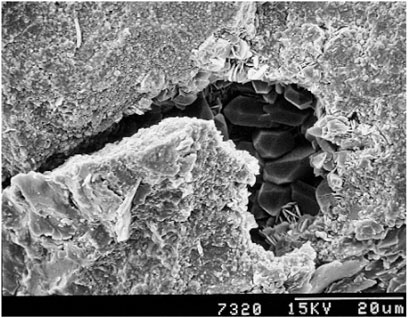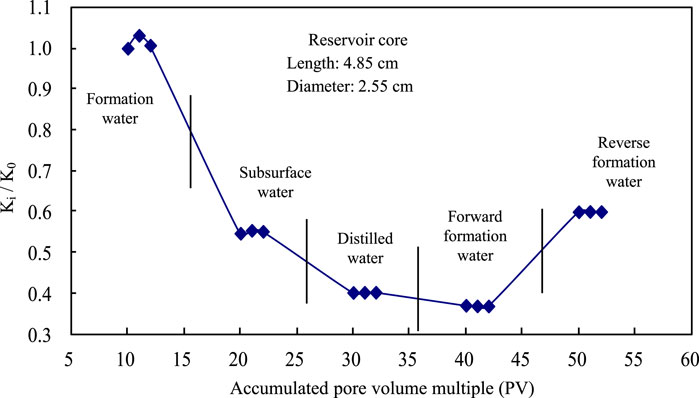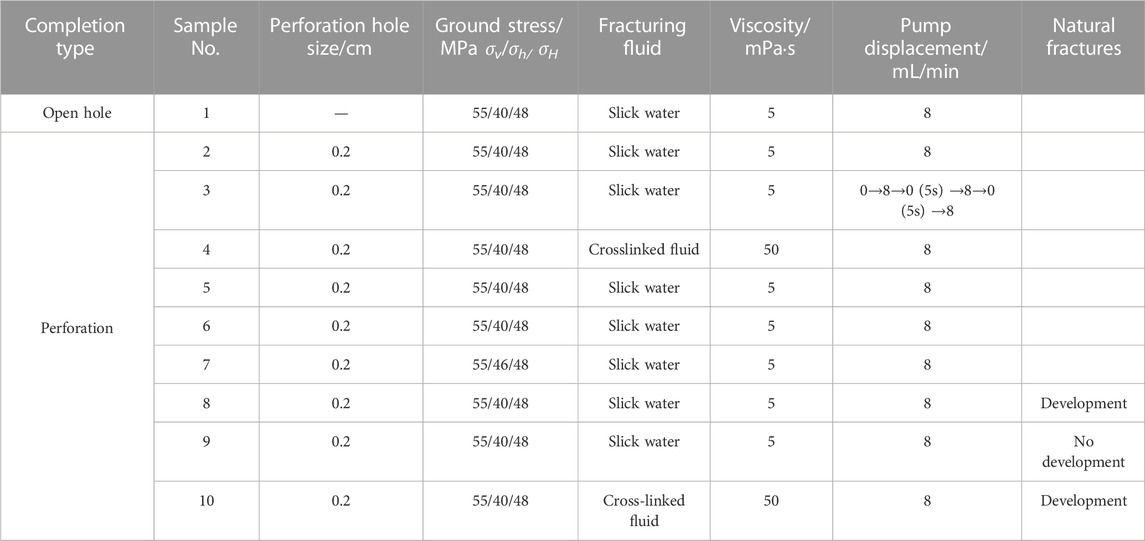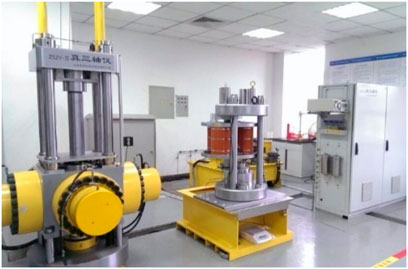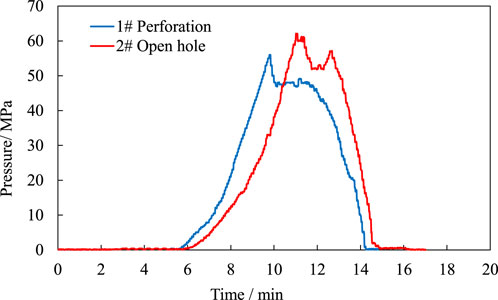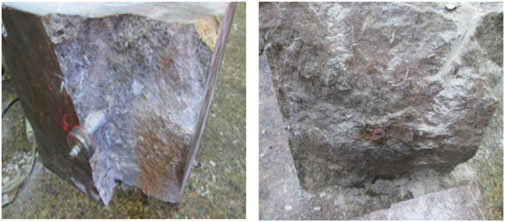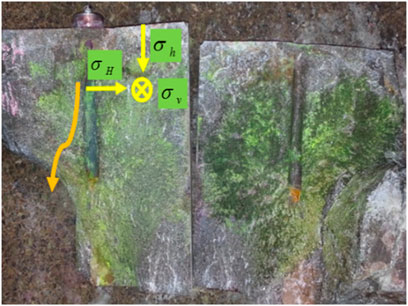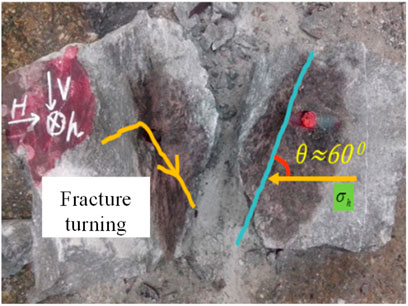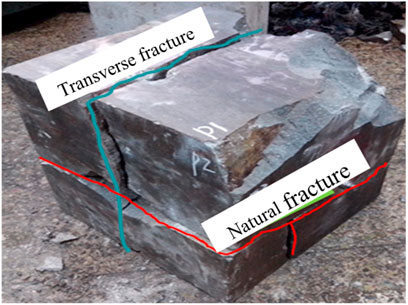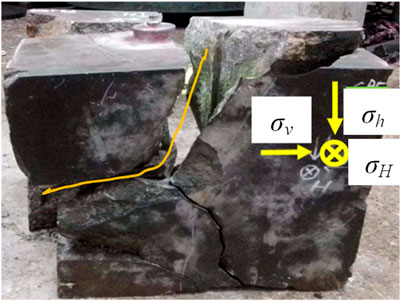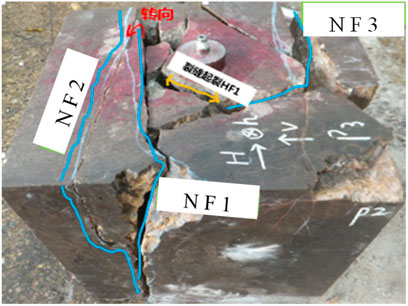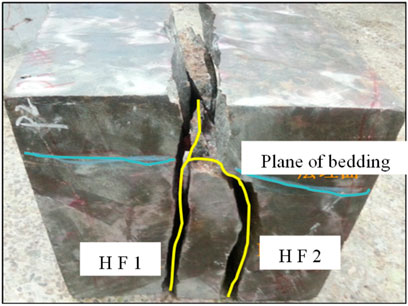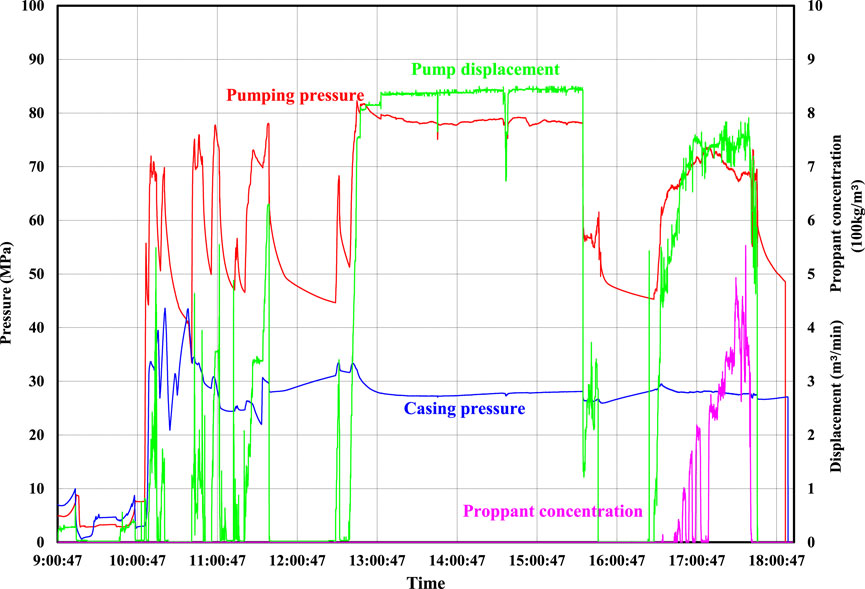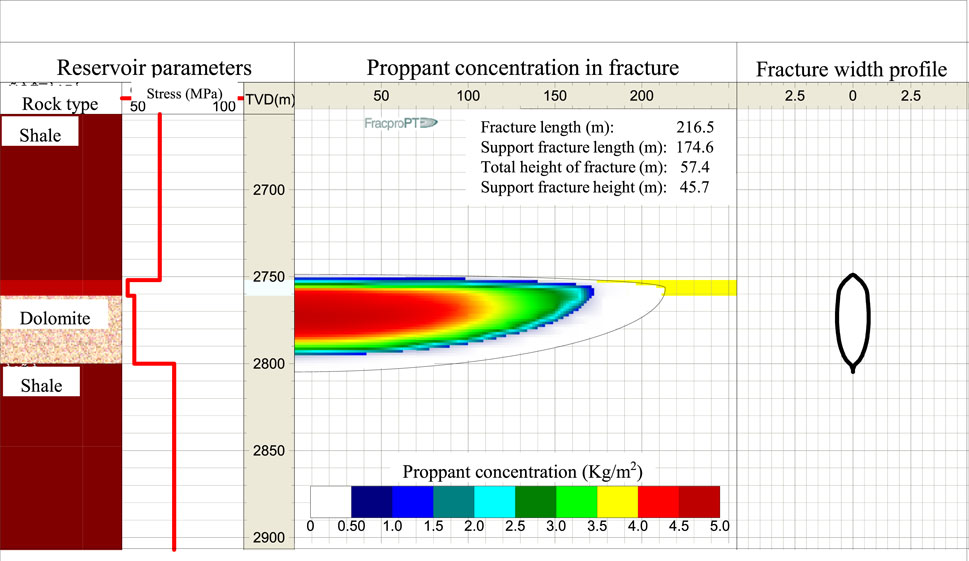- 1Engineering Technology Research Institute of PetroChina Southwest Oil and Gas Field Company, Chengdu, China
- 2National Energy R&D Center of High Sulfur Gas Exploitation, Guanghan, China
- 3Qilin Gas Production Area of the Fourth Oil Production Plant of PetroChina Changqing Oilfield Company, Yulin, China
The limestone reservoir of the Da’anzhai section is the main production layer of Jurassic tight oil in central Sichuan, with tight and strongly heterogeneous reservoir rocks. In the early stages, small-scale plug removal and acidification techniques were mainly applied to the dacite section of the reservoir. However, using a single conversion method was not suitable for tight reservoirs with underdeveloped fractures. To address this challenge, we conducted large-scale real-world triaxial simulation test system experiments on hydraulic fracture propagation using samples from dense limestone outcrops. The aim was to elucidate the laws of hydraulic fracture propagation in dense limestone oil reservoirs. The L1 well in this area was selected to test the volumetric fracturing technology in order to achieve a breakthrough in test production and the reconstruction technology of the Da’anzhai section of the tight limestone reservoir. The experiments have shown that low stress differences, natural fracture development, and low viscosity slippery water are favorable factors for obtaining complex fracture morphology. In contrast to the construction parameters, the structural properties of the rock are the dominant factors in the formation of complex fracture morphologies. By optimizing the geological dessert and implementing targeted technological measures, bulk fracturing has been proven to be feasible for the dense limestone reservoir in the Da’anzhai section.
1 Introduction
Unconventional tight oil reservoirs are widely distributed in China. For example, the Chang 7 section of the Yanchang Formation in the Ordos Basin, the carbonate rock of the Shahejie lacustrine formation in Bohai Bay, the Cretaceous Marl of the Jiuquan Basin, the Permian Marl of the Junggar Basin, and the Lower Tertiary Marl of the Jianghan Basin are all unconventional tight oil reservoirs. In addition, the Jurassic oil resources in the central Sichuan Basin are estimated at 1.07 billion tons. After 50 years of development, 160 million tons of tertiary reserves have been acquired in central Sichuan, including 81.18 million tons of proven reserves and 5.3603 million tons of technically recoverable reserves. However, the resource discovery rate is only 15% and the proved discovery rate is only 7.6%. Clearly, the central Sichuan region is rich in hydrocarbon sources and abundant resources, making it one of the largest oil-producing regions in China yet to be developed on a large scale. As a result, the development and utilization of low permeability tight oil and gas reservoirs will play an increasingly important role in increasing the reserves and production of oil and gas fields, especially with the advent of later stages of field development. This is of great practical importance to China.
Tight oil, or shale oil, is an important source of energy worldwide. The United States’ Bakken and China’s Yingtan are typical representatives of the commercial development of tight oil globally (Warpinski et al., 2009; Wei et al., 2013; Du et al., 2014; Yang et al., 2014; Yu et al., 2014). Currently, the domestic Changqing and Daqing oilfields are also making great progress in the exploration of tight oil (Li et al., 2015; Cao, 2022). The aforementioned blocks’ tight sandstone reservoirs have all undergone volumetric fracturing using induced stress, which has been found to greatly affect the shape and size of the fracture network’s contribution to well production (Mayerhofer et al., 2010; Wang et al., 2023a). A new parameter, “Reservoir Renovation Volume (SRV)," has been proposed to characterize the degree of impact on the production of a fracturing well after fracturing. The researchers also studied the initiation and extension patterns of multiple fractures in the vicinity of the borehole region. They have proposed a conceptual diagram of radial fracture network extension (Mcdaniel, 2010). In addition, using the step-by-step construction method, researchers have improved the connectivity between the natural and main fractures, thereby increasing the complexity and effectiveness of fracture network fracturing (Soliman et al., 2010; Hou et al., 2016; Hou et al., 2019) compared and evaluated the factors affecting the expansion of shale, limestone, and tight sandstone with the fracture expansion of rocks. They concluded that the initiation and expansion of hydraulic fractures in highly brittle rocks are mainly affected by fracture toughness. On the other hand, the formation of complex fracture networks in low-brittleness rocks is influenced by the use of low-viscosity fracturing fluid. In addition, Cai et al. (2022) conducted experiments on rock mechanics param of Gulong shale to investigate the impact on fracture expansion. They optimized the perforation mode, cluster spacing, proppant particle size combination, and shale oil reservoir type, as well as the fracturing construction control process. These improvements enhanced the combined volume fracturing technology for Gulong shale oil reservoirs. By establishing a three-dimensional fracture initiation and propagation model, taking into account the effects of fracturing parameters such as well completion method, in situ stress, natural fractures, cluster spacing, and displacement on the initiation and propagation of fracturing fractures, the difficulties of indoor conventional experiments limited by small rock and crack sizes and large boundary effects were overcome (Wang et al., 2020; Wang et al., 2020; Tan et al., 2020; Tan et al., 2021a). However, most of the rock and fracture mathematical models built were based on ideal assumptions, which were somewhat different from actual working conditions (Lin et al., 2020; Tang et al., 2021b; Li et al., 2021; Lucas et al., 2021; Li et al., 2022; Wang et al., 2022) conducted true triaxial Fracking experiments on 30 cm and 50 cm cement cube rock mass with prefabricated natural fractures through concrete similar simulation experiments, respectively, and studied the effects of natural fracture development, dip angle and strike, and different stress differences on fracture propagation. Based on the characteristics of the reservoir and the simulation results of large-scale fracturing experiments, it is recommended to adopt a volume fracturing concept and process technology that focuses on “large liquid volume, large displacement, and expanded swept volume” to achieve the goal of transforming complex fracture networks. Wang et al. (2023b) conducted a temporary plugging agent sealing pressure test about multiscale temporary plugging fracturing shale oil reservoirs, which elucidated the effect of different types, combinations and concentrations of temporary plug agents on the sealing pressure. Based on the similarity criterion design of dimensional analysis method (π theorem) physical simulation experiments, Kong et al. (2023) conducted unconventional volume fracturing physical simulation experiments using an artificial sample system, simulating the equilibrium initiation and extension behavior of fracturing fractures under five unconventional volume fracturing processes: hydraulic pulse pretreatment, cluster temporary blocking, flow limiting method, cyclic loading and unloading, and pulse intermittent fracturing.
Despite years of progressive exploration and development of the central Sichuan basin’s Jurassic oil reservoirs, it has been difficult to significantly increase their productivity scale and recovery factor, which has left central Sichuan’s annual oil production inadequate to its resources and vast oil-bearing area. The shelly limestone reservoir of the Da’anzhai section is the main production layer of Jurassic tight oil in central Sichuan. In the early stages, the acidification process was mainly tested on different acid fluid systems, such as conventional acid, gelling acid, and drag-reducing acid, showing single-process and small-scale properties. Field tests have shown that the former process is not suitable for tight limestone reservoirs with underdeveloped fractures. Whether this type of reservoir can be learned from the successful experience of volumetric fracturing conversion in tight sandstone reservoirs at home and abroad is an urgent question to be answered. Physical simulations of true triaxle fracture have been performed with outcropping limestone samples to explore fracture propagation laws in limestone reservoirs in terms of stress differences, natural fractures, and fluid types. Well L 2 was selected for testing of the volumetric fracturing technology and the results demonstrated that the tight limestone reservoir in the Da’anzhai section is viable for volumetric fracturing.
Simulations of realistic triaxle physics have demonstrated the influence of stress orientation and magnitude on fracture behavior in the Da’anzhai Section, a compact rock formation. Performance tests show that changes in fracture parameters can effectively control fracture propagation and enhance reservoir connectivity. The findings suggest that production of oil and gas from tight reservoirs can be significantly increased by optimizing fracture design. This study has successfully investigated the hydraulic fracturing process in the Da’anzhai Section of the Sichuan Basin tight reservoir through realistic triaxle physics simulations and process tests. The results demonstrate the importance of optimizing fracture design for enhanced reservoir connectivity and oil/gas production.
2 Reservoir characteristics of Da’anzhai section
The total thickness of the Da’anzhai reservoir ranges from 40 to 110 m. It is mostly composed of bioclastic limestone, which is mostly developed in the first and third sectors of the Da’anzhai Formation. Individual layers within the reservoir are typically 3–20 m thick, with cumulative thickness ranging from 5 to 40 m. Lianggaoshan has a layer thickness of 50–150 m. The reservoirs in the Liangshang section consist primarily of pale gray powdery to fine-grained quartz sandstone with lithic feldspar. The layers are generally 1–4 m thick, with cumulative thickness ranging from 10 to 20 m. The Shaximiao Formation is primarily located in the lower part of Shaximiao and consists of light gray fine to medium to coarse-grained lithic feldspar quartz sandstone ranging in thickness from 5 to 30 m. The reservoir exhibits significant vertical variability, including the presence of limestone and sandstone. Compared with shale oil reservoirs at home and abroad, the shale oil reservoirs in central Sichuan Basin are characterized by vertical lithologic interaction (shale, sandstone, limestone). There are major differences in rock mechanics and geostress properties in the vertical direction. In addition, the physical properties of the reservoir are poor, with porosity ranging from 1.4% to 4.5% and generally less than 2%, permeability ranging from 0.001 to 0.018 mD, water saturation from 15% to 50%, and TOC content ranging from 1.2% to 1.7%. Overall, it exhibits extremely low porosity and permeability. The original formation pressure coefficient of the reservoir is 0.8–1.7, the geothermal gradient is 2.07°C/m, the crude oil density is 0.6–0.8 g/cm3, and the viscosity is 0.2–4.0 mPa·s.
2.1 Microstructural characteristics of reservoirs
The displacement pressure of the Da’anzhai section reservoir is 18.27 MPa, which belongs to the ultra-high displacement pressure. The median pressure is 75.85 MPa, which belongs to ultra-high capillary pressure. The median radius of the pore throat is extremely small. The scanning electron microscope shows that the reservoir has developed pinholes, well-developed pores, and good connectivity. Crude oil is visible in the pores, and microfractures are developed (Figures 1, 2). Figure 2 shows a diameter of 2,468.56 m in Da’anzhai, where the intergranular dissolved pores and throat are filled with oil.
2.2 Mineral and sensitivity characteristics
The X-ray diffraction experiment shows that the mineral composition of the reservoir is mainly Calcite, containing a small amount of argillaceous, siliceous, erogenous clastic, organic matter and Pyrite. In clay minerals, Yimeng mixed bed, Pyrite and other sensitive mineral components are widespread, indicating that there is potential damage to the reservoir. The sensitivity experiment of the reservoir indicates that the reservoir has moderate to strong water sensitivity characteristics (Figure 3), which requires the liquid entering the well to have good anti swelling performance.
2.3 Reservoir space
The Da’anzhai limestone reservoir has a mainly microporous structure created by dissolution, structural fractures, and dissolution fractures. Meanwhile, the major reservoir spaces in the Lianggaoshan and Shaximiao sandstone reservoirs consist of intergranular and intergranular dissolution pores with small residual intergranular pores and structural microfractures. Although the fractures in Chung-guyok consist of a gentle overall structure, there are weak stresses and strong heterogeneity in the development and distribution of the fractures. The fractures in the Da’anzhai reservoir are mainly characterized by low-sloping, horizontal, small, and microfractures. However, there are high-angle, large and medium-sized structural fractures that have not yet developed. Fractures are relatively developed in regions of strong stress, which include fault ends, structural axes, turning points, nasal protrusions, kinks, and steeply varying zones. The strike of the main fracture on the aircraft is generally consistent with a structural strike. The effects of fissures are manifested in the following ways:
Fractures are essential for achieving high production rates in oil wells, and the majority of high production wells are associated with fractures. Production capacity can vary significantly from well to well, often resulting in low, small or no production in the vicinity of high yield wells. In addition, there is often a discrepancy between the permeability of rock samples and the measured permeability of oil well production. To further develop this argument, more specific examples and thorough justification should be incorporated throughout the paper.
The measured permeability of a large number of cores from various Jurassic beds is generally less than 1.0 mD, reflecting the permeability of pores in the rock matrix. However, when it comes to high production industrial wells, the interpreted permeability at well test time often reaches tens or even hundreds of millers. This can be attributed to the percolation nature commonly found in typical fractured reservoirs. And the permeability of these wells can vary greatly depending on several key factors, such as the degree of fracturing, the pore structure, and the effect of any external forces that may occur. An in-depth analysis of fractured reservoirs is therefore essential to accurately interpret such data. In summary, the study of permeability in fractured reservoirs is a complex yet essential task that requires a holistic understanding of geological structures and processes. By implementing advanced techniques and tools, we can further improve our understanding of these reservoirs and pave the way for more effective management and utilization of our valuable resources.
2.4 Rock mechanics and in situ stress characteristics of reservoir
Rock mechanics experiment shows that the Young’s modulus of the reservoir is high, ranging from (5.4–6.8) × 104MPa, while the Poisson’s ratio is low, ranging from 0.21 to 0.25 (as shown in Table 1). This indicates that the reservoir’s rock is strong and resistant to deformation, as well as more likely to respond elastically to stress. These properties make it a good candidate for oil and gas storage.
In order to provide a more specific explanation and relate this information to reservoir management, various factors need to be considered. The Young’s modulus of a rock determines its elasticity under stress, while the Poisson’s ratio measures deformations perpendicular to the applied force. Thus, a high Young’s modulus implies that the reservoir can withstand high pressures, while a low Poisson’s ratio implies that the reservoir is less susceptible to destructive changes in shape or volume under stress. Overall, these factors contribute to making the reservoir a desirable location for oil and gas storage. However, a thorough investigation of geological history, current market demand and future projections, among other things, is necessary for a complete understanding. In order to provide a more concrete explanation and relate this information to reservoir management, we need to consider several factors. The Young’s modulus of a rock indicates its elasticity under stress, while the Poisson’s ratio quantifies the deformation normal to the applied force. Thus, a high Young’s modulus implies that the formation is able to withstand high pressures, while a low Poisson’s ratio implies a low value for the reservoir.
The maximum horizontal stress measured in the differential strain experiment was 68.6 MPa. In addition, the minimum horizontal and axial stresses of the specimen were recorded as 55.0 MPa and 59.3 MPa, respectively. By combining the differential strain and paleomagnetic experiments, the direction of maximum horizontal stress of the specimen was determined to be 114.4° (Table 2).
The high stress difference coefficient of the Da’anzhai reservoir makes it difficult to form complex fractures. It is necessary to maximize the net pressure inside the fracture to create the conditions for complex fracture formation. Moreover, techniques such as filling the fracture with a low-density liquid can be employed to increase the net pressure. Complex fracture formation has significant implications and applications, and further exploration of its effects and practical examples would be beneficial.
3 Physical simulation tests of fracturing
The hydraulic fracturing technique plays a crucial role in enhancing oil and gas production in tight reservoirs. Understanding the fracturing mechanics and optimizing fracturing param are important for successful stimulation. This study focuses on the Da’anzhai section in the Sichuan Basin, aiming to explore the true triaxle physics simulations and process tests for hydraulic fracturing (Table 3).
3.1 Large scale true triaxle simulation test system
The large-scale true triaxle simulation test system consists of a triaxle shear test rack, an MTS servo hydraulic pump, a Local-AT14 acoustic emission sensor, a power stabilizer, a water-oil isolator, and other auxiliary equipment. The overall structure is shown in Figure 4. An MTS servo booster pump was used to pump high-pressure liquid into the simulated borehole. The MTS Booster pump has a program controller that can pump liquid with constant or variable displacements. The MTS data collection system records param such as pressure and displacement of the fracturing fluid. A sliding sleeve oil-water separator is used in the thick-walled, cylindrical autoclave to separate the MTS working medium from the fracturing fluid. With a volume of 700 mL and a pressure-bearing capacity of 70 MPa, the system meets the requirements of a simulated fracture test.
3.2 Sample preparation and experimental methods
3.2.1 Sample preparation
The sample was taken from a dense limestone outcrop in the Da’anzhai section of central Sichuan. Using a rock cutting machine, the sample was cut into a cube rock block measuring 300 mm × 300 mm × 300 mm in size. A diamond core drill bit was used to drill a core on site, simulating a circular bore hole with a depth of 18 mm and 16 bore. We created 3 clusters of perforation simulations using a stainless-steel mold, where the simulated phase was a 90° spiral perforation, the perforation hole diameter was 2.0 mm, and the perforation depth was 40 mm. The sample is shown in Figure 5. To more clearly identify the geometry of fractures, we mixed dyes into the fracturing fluid (Figures 6A, B). After the experiment was completed, we knocked open the specimen with a hammer alone. The hole is then filled with filling material, glue is injected and the hole is finally sealed. To simulate the perforation, a stainless-steel mold was used to create 3 clusters of perforation simulations, with a simulated phase of 90° spiral perforation, a perforation hole diameter of 2.0 mm, and a perforation depth of 40 mm. The sample is shown in Figure 5. To more clearly trace the geometry of fractures, dyes were mixed into the fracturing fluid (Figure 6). After the experiment was completed, the fracturing fracture to observe the morphology of the fracture.
To ensure quasi-static fracture propagation and prevent rapid breaking through the outer surface of the specimen, the fracture tip propagation velocity was clamped by increasing the confining pressure. The sample was then placed in the press and the pressure plate and other components were installed. To ensure uniform loading, a rubber gasket was placed between the pressure plate and the specimen. After mounting, a three-way confining pressure was applied by a hydraulic pressure source before the fracturing fluid was pumped into the simulated wellbore at a predetermined displacement until the sample ruptured. Finally, the morphology of the formed fractures was observed and param such as pump injection pressure and displacement during fracture propagation were recorded using an MTS test machine.
3.2.2 Experimental parameter design
The simulated geomechanically environment in the experiment comprises an average formation temperature of 70°C, an average elastic modulus of 5.865 × 104 MPa, an average Poisson’s ratio of 0.23, and an average compressive strength of 356.02 MPa. In the experimental triaxle stress design, the maximum horizontal principal stress is 55 MPa, the minimum horizontal principal stress is 40 MPa, and the vertical principal stress is 48 MPa. Various conditions such as different rock types, wellbore trajectories, and fluid types are used to model the morphology of fracture initiation and propagation.
3.3 Analysis of test results
We conducted 10 sets of indoor simulation tests to investigate the impact of completion method, type of fracturing fluid, in situ stress, and the observed greater increase in fracture length when using a low-viscosity fracturing fluid. Third, in situ stress conditions in the formation should be taken into account, as they have a significant effect on the orientation of the fracture. Finally, it is important to take into account pump displacements and specimen sizes, which have a direct effect on the fracture propagation pattern. Overall, the experimental findings suggest that the pattern of fracture elongation is determined by a combination of factors, namely, pump displacement, natural fracture, and specimen size.
3.3.1 Impact of completion methods
Sample 1 simulates open-hole completion, while sample 2 simulates perforation completion. From Figure 7, it can be seen that sample 1 # shows a break at 63 MPa, while sample 2 # shows a break at 56 MPa. Analyzing the highest experimental pump pressure values corresponding to the two completion methods in Figure 7, it is found that perforation completion is helpful for crack initiation.
Sample 3 was also subjected to simulated perforation completion, but repeated loading tests did not reveal any significant fractures. When the sample was pried open (Figure 8), it was observed that there was no fracture upon prying open the sample (Figure 8), it was found that the pre-drilled hole remained intact without fracturing. Indoor tests demonstrated that the fracture pressure of the open hole completion method was lower compared to the perforated completion method. This phenomenon can be attributed to the following reasons. First, the inability to create a complete perforation channel penetrating the wellbore indoors leads to increased energy loss at the simulated wellbore perforation point. Second, some holes are sealed by cementing fluid. Additionally, the open hole completion method ensures sufficient infiltration of fracturing fluid into the rock sample.
3.3.2 Impact of fracturing fluid type
Figure 9 illustrates the test results for a sample numbered 4 tested with a cross-linked fluid. Initially, the onset of fracture does not follow the direction of the maximum horizontal principal stress due to the presence of a natural fracture surface near the bore. However, after a certain amount of expansion, the effect of the 3D principal stress becomes dominant and, as a result, the fracture turns in the direction of the largest transverse principal stress. On the other hand, Figure 10 shows the test findings for a sample numbered 5 tested with pure water. In this case, hydraulic fractures also showed a turning angle, but there was a 60° angle between the turning line and the direction of the minimum horizontal principal stress. Moreover, the fracture surface exhibits kinks and tilts. The limited penetration of the cross-linked fluid into the strata reduces the likelihood of shear slip and expansion leading to degenerate fractures. In addition, pure water has the ability to propagate towards natural fractures more easily, which can result in a lower pressure drop of the flowing fluid within the fracture, thus increasing the probability of new fractures forming at the ends of natural fractures.
3.3.3 Influence of ground stress difference
Figure 11 illustrates the results of the test performed on sample 6 with a horizontal stress difference of 8 MPa. Similarly, Figure 12 shows the corresponding results for sample 7 with a level stress difference of 2 MPa. The fracture morphology of sample 6# after compression is relatively simple, exhibiting a single transverse main fracture that fully penetrates the natural fracture surface without any turning or dynamic bifurcation. In contrast, the fracture in sample 7 shows a tendency to turn in the direction of the natural fracture. Lateral stress differences play a significant role in fracture propagation in rocks. A larger transverse stress difference leads to a restricted fracture initiation and propagation direction, resulting in the formation of a simpler fracture morphology. In turn, when the transverse stress difference is small, fractures tend to turn and dynamically bifurcate, facilitating connections with natural fractures and eventually complex networks. Understanding the effect of transverse stress differences on fractures is therefore crucial for improving the accuracy of rock mechanics models.
3.3.4 Natural fracture impact
Experimental results show that natural fractures and bedding have a significant impact on the complexity of fracking. The photographs in Figures 13–15 demonstrate this effect by testing samples of different types of fractures with different fluids. Specifically, Figure 13 shows a test using smooth water on an 8 # sample with well-developed natural fractures. In contrast, Figure 14 shows a test using smooth water on sample 9 # with an underdeveloped natural fracture. In addition, Figure 15 illustrates a test using a cross-linked liquid on a 10 # sample with well-developed natural fractures. When comparing and analyzing the 8 # and 9 # samples, we find that the more developed the natural fractures and bedding, the more complex the hydraulic fracture morphology becomes, resulting in a larger spreading of the fracture network. On the other hand, it is challenging to form complex fracture morphologies when using smooth water for hydraulic fracturing in underdeveloped natural fracture reservoirs (as demonstrated in the comparison between samples 9 # and 10 #). In contrast, the use of cross-linked fracturing can increase the complexity and diversity of hydraulic fractures in naturally fractured reservoirs.
Physical model experiments have shown that small stress differences, natural fracture development, and low viscosity water can promote the formation of complex fracture morphologies. The randomness of the direction of the fracture bifurcation is mainly related to factors such as the degree of natural fracture development and the local stress field. According to our analysis, the rock itself dominates the formation of complex fracture morphologies, rather than the building parameters.
4 Process testing
Located in central Sichuan of China, L 2 is an appraisal well consisting of brownish-gray crustal limestone in the Da’anzhai section. Conventional logging data indicates the development of reservoir fractures, and geological logging shows “oil and gas invasion” at 2,772.0–2,773.0 m, which is comprehensively interpreted as an oil and gas reservoir, and the specific physical parameters of the reservoir are shown in Table 4. In the initial stage of stimulation treatment, correlated transitions are performed on the trap-deceit cross section. 60.3 m3 of conventional acid was injected with a displacement of 2.0–2.5 m3/min and a pump pressure of 83–85 MPa. After acidification, a test gas volume of 600 m3/d was obtained.
Since the desired results from the acidification process were not achieved, it was decided to conduct hydraulic fracturing tests based on the concept of “large liquid volume, large displacement, and expansion of affected volume”. According to the geological characteristics of the reservoir and the engineering conditions of the L1 well, the feasibility of fracturing was demonstrated (Figure 16). A hybrid fracture pattern of a linear gel and a cross-linked fluid was used. Through the Φ114.0 mm oil well tubing, a net liquid volume of 2042.7 m3 was injected into the formation with a flow rate of 7.5–8.4 m3/min and a pump pressure of 72–78 MPa. After hydraulic fracturing process, the well achieved a breakthrough from “no production” to a production rate of 2 t/d for oil and 3,000 m3/d for gas, demonstrating successful results.
The actual data from the fracture process of this well were analyzed using software to simulate and analyze the fracture morphology, which is depicted in Figure 17. The simulation results indicate a total fracture length of 216.5 m, an effective fracture length of 174.6 m, and a fracture height of 57.4 m at pressure. Longer range fracture transitions can be obtained by effectively controlling the fracture height. This analysis is important as it provides valuable insights into the efficiency and effectiveness of the fracturing process for this well.
Seismic monitoring revealed a fracture zone with a length of 200 m, a width of 170 m and a height of 64 m, successfully achieving the volumetric fracture target. The testing of Well L2 using volumetric fracturing represents a technological breakthrough in the development of compact limestone reservoirs in the Da’anzhai section of the Sichuan Basin.
5 Conclusion
(1) The reservoir rocks in the Da’anzhai section are dense and show varying degrees of water sensitivity, ranging from moderate to strong. In addition, these rocks exhibit heterogeneity, with variations in mineral composition and texture throughout the formation.
(2) Large scale physical model experiments have shown that complex fracture morphology can be achieved through a combination of factors, including low stress differences, the presence of natural fractures, and the low viscosity of fracking fluids. However, beyond the parameters of the fracture process itself, the structural properties of the reservoir rock play a dominant role in determining the final fracture pattern.
(3) On-site process tests have demonstrated that significant fracturing transformations can be achieved in the test well by optimizing geological parameters and adopting specific volume fracturing techniques. These methods are based on reservoir properties, including the need for a large liquid volume, displacement, and expansion of the affected region. Taken together, these findings suggest that bulk fracturing in dense limestone reservoirs in the Da’anzhai section of central Sichuan is a viable approach.
Data availability statement
The raw data supporting the conclusion of this article will be made available by the authors, without undue reservation.
Author contributions
SL: Conceptualization, Formal Analysis, Writing–original draft, Writing–review and editing. YF: Funding acquisition, Project administration, Supervision, Resources, Writing–review and editing. YW: Data curation, Formal Analysis, Software, Writing–original draft. YZ: Writing–review and editing. ZL: Methodology, Resources, Validation, Writing–original draft. ZJ: Data curation, Methodology, Supervision, Writing–review and editing. WC: Funding acquisition, Resources, Writing–review and editing. JM: Data curation, Methodology, Writing–review and editing.
Funding
The author(s) declare financial support was received for the research, authorship, and/or publication of this article. This work was supported by the scientific research project of PetroChina Southwest Oil and Gas Field Company in 2022: volume fracturing technology research of Shale oil in Lianggaoshan Formation of Sichuan Basin (No. 20220302-10).
Acknowledgments
The authors are grateful for the support of the scientific research project of PetroChina Southwest Oil and Gas Field Company. We are also grateful to Professor Bing Hou and his research team from China University of Petroleum (Beijing) for providing reliable experimental data for the revision of our paper.
Conflict of interest
SL, YF, YW, ZL, ZJ, WC, and JM were empolyed by the Engineering Technology Research Institute of PetroChina Southwest Oil and Gas Field Company and YZ was employed Qilin Gas Production Area of the Fourth Oil Production Plant of PetroChina Changqing Oilfield Company
Publisher’s note
All claims expressed in this article are solely those of the authors and do not necessarily represent those of their affiliated organizations, or those of the publisher, the editors and the reviewers. Any product that may be evaluated in this article, or claim that may be made by its manufacturer, is not guaranteed or endorsed by the publisher.
References
Cai, M., Tang, P. F., Wei, X., Liu, Y., and Zhang, H. (2022). Optimization of composite volume fracturing technology for Gulong shale oil. Petroleum Geol. Oilfield Dev. Daqing 41 (3), 156–164. doi:10.19597/J.ISSN.1000-3754.202111084
Cao, B. G. (2015). Discussion on volume fracturing method of horizontal wells in tight reservoir of Ordos Basin. Reserv. Eval. Dev. 5 (5), 62–68. doi:10.13809/j.cnki.cn32-1825/te.2015.05.014
Du, J. H., He, H. Q., Li, J. Z., Yang, T., Huang, F. X., Guo, B. C., et al. (2014). Progress in China’s tight oil exploration and challenges. China Pet. Explor. 19 (1), 1–9. doi:10.3969/j.issn.1672-7703.2014.01.001
Hou, B., Tan, P., Chen, M., Yuan, L., Xiong, Z. Y., and Xu, C. L. (2016). Experimental investigation on propagation geometry of hydraulic fracture in compact limestone reservoirs. Chin. J. Geotechnical Eng. 38 (2), 219–225. doi:10.11779/CJGE201602004
Hou, Z. K., Cheng, H. L., Sun, S. W., Chen, J., Qi, D. Q., and Liu, Z. B. (2019). Crack propagation and hydraulic fracturing in different lithologies. Appl. Geophys. 16 (2), 243–251. doi:10.1007/s11770-019-0764-3
Kong, X. W., Yan, R. T., Xu, H. X., and Li, S. (2023). Experiment on equilibrium initiation and extension of multiple clusters of fractures based on true triaxial physical simulation. Nat. Gas. Geosci. 34 (7), 1123–1136. doi:10.11764/j.issn.1672-1926.2023.03.010
Li, J. W., and Wu, K. (2022). Impact of horizontal weak interfaces on the hydraulic fracturing from height growth to lateral propagation. Proceedings of the Paper URTEC-3723910-MS, presented at the SPE/AAPG/SEG Unconventional Resources Technology Conference, Houston, Texas, USA, June 2022.
Li, S., Zhang, H. L., Wang, M., Zhang, X., and Zhou, C. L. (2021). Experimental evaluation and process optimization of temporary plugging to acid-frac in fractured carbonate reservoirs. Chem. Eng. Oil Gas 50 (3), 90–95. doi:10.3969/j.issn.1007-3426.2021.03.015
Li, Z. X., Li, J., Qu, X. F., Li, X. W., Lei, Q. H., and Fan, J. M. (2015). The experiment and recognition of the development of Chang 7 tight oil in Ordos basin. Nat. Gas. Geosci. 26 (10), 1932–1940. doi:10.11764/j.issn.1672-1926.2015.10.1932
Lin, B. T., Shi, C., Zhuang, L., You, H. J., and Huang, y. (2020). Study on fracture propagation behavior in ultra-heavy oil reservoirs based on true triaxial experiments. Petroleum Explor. Dev. 47 (3), 651–660. doi:10.1016/S1876-3804(20)60082-9
Lucas Wesley, B., Bruce Roman, M., and Tran, V. P. (2021). Innovative analysis of treatment well data determines cluster efficiency, assesses fracture complexity, and provides fracture geometry in unconventional reservoirs. Seg. Glob. Meet. Abstr., 182–223. doi:10.15530/ap-urtec-2021-208315
Mayerhofer, M. J., Lolon, E. P., Warpinski, N. R., Cipolla, C. L., Walser, D., and Rightmire, C. M. (2010). What is stimulated reservoir volume. SPE Prod. operations 25 (1), 89–98. doi:10.2118/119890-pa
Mcdaniel, B. W. (2010). Horizontal wells with multistage fracs provide better economics for many lower permeability reservoirs. Proceedings of the Paper SPE 113427 prepared for the presentation at the SPE Asia Pacific Oil and Gas Conference and Exhibition. Brisbane. Queensland. Australia. 18–20. October 2010.
Soliman, M. Y., East, L. E., and Augustine, J. R. (2010). Fracturing design aimed at enhancing fracture complexity. Soc. Petroleum Eng. doi:10.2118/130043-MS
Tan, P., Jin, Y., and Pan, P. (2021a). Hydraulic fracture vertical propagation behavior in transversely isotropic layered shale formation with transition zone using XFEM-based CZM method. Eng. Fract. Mech. 248, 107707. doi:10.1016/j.engfracmech.2021.107707
Tan, P., Pan, P., Zhang, R. X., Jin, Y., Zhou, Y., Kao, J., et al. (2020). Experimental investigation into hydraulic fracture geometry and proppant migration characteristics for southeastern Sichuan deep shale reservoirs. J. Petroleum Sci. Eng. 184, 106517. doi:10.1016/j.petrol.2019.106517
Tang, P. F., Liu, Y., Qi, S. L., Deng, D. W., and Li, C. R. (2021b). Physical simulation experiment on hydraulic fracturing of large-scale tight sandstone outcrop. Fault-Block Oil Gas Field 28 (3), 397–402. doi:10.6056/dkyqt202103021
Wang, D. B., Zhou, F. J., Li, Y. P., Yu, B., Martyushev, D., Liu, X. F., et al. (2022). Numerical simulation of fracture propagation in Russia carbonate reservoirs during refracturing. Petroleum Sci. 19 (6), 2781–2795. doi:10.1016/j.petsci.2022.05.013
Wang, D. B., Zlotnik, S., Díez, P., Ge, H., Zhou, F. J., and Yu, B. (2020b). A numerical study on hydraulic fracturing problems via the proper generalized decomposition method. Comput. Model. Eng. Sci. 122, 703–720. doi:10.32604/cmes.2020.08033
Wang, D., Dong, Y., Sun, D., and Yu, B. (2020a). A three-dimensional numerical study of hydraulic fracturing with degradable diverting materials via czm-based fem. Eng. Fract. Mech. 237, 107251. doi:10.1016/j.engfracmech.2020.107251
Wang, Y., Fan, Y., and Wang, X. J. (2023a). Study on migration law of multiscale temporary plugging agent in rough fractures of shale oil reservoirs. Front. Phys. 11, 1228006. doi:10.3389/fphy.2023.1228006
Wang, Y., and Lv, Z. F. (2023b). Composite stimulation technology for improving fracture length and conductivity of unconventional reservoirs. Front. Phys. 11, 1181302. doi:10.3389/fphy.2023.1181302
Warpinski, N. R., Mayerhofer, M. J., Vincent, M. C., Cipolla, C. L., and Lolon, E. P. (2009). Stimulating unconventional reservoirs: maximizing network growth while optimizing fracture conductivity. J. Can. Petroleum Technol. 48 (10), 39–51. doi:10.2118/114173-MS
Wei, H. F., Fan, Z. Y., and Yuan, X. C. (2013). Review on new advances in foreign tight oil development technology and their enlightenment. Petroleum Geol. Recovery Effic. 20 (2), 62–66. doi:10.13673/j.cnki.cn37-1359/te.2013.02.014
Yang, H., Wang, R., Zhou, W., and Li, L. (2014). Beneficial effects of β-conglycinin on renal function and nephrin expression in early streptozotocin-induced diabetic nephropathy rats. J. China Univ. Petroleum Ed. Nat. Sci. 38 (6), 78–85. doi:10.1017/S0007114513001876
Keywords: tight oil reservoir, Da’anzhai, true triaxial, volume fracturing, technology test
Citation: Li S, Fan Y, Wang Y, Zhao Y, Lv Z, Ji Z, Chen W and Min J (2023) True triaxial physics simulations and process tests of hydraulic fracturing in the Da’anzhai section of the Sichuan Basin tight oil reservoir. Front. Energy Res. 11:1267782. doi: 10.3389/fenrg.2023.1267782
Received: 27 July 2023; Accepted: 24 August 2023;
Published: 02 November 2023.
Edited by:
Peng Tan, CNPC Engineering Technology R&D Company Limited, ChinaReviewed by:
Daobing Wang, Beijing Institute of Petrochemical Technology, ChinaMingjun Chen, Southwest Petroleum University, China
Xiaopeng Yan, Changzhou University, China
Copyright © 2023 Li, Fan, Wang, Zhao, Lv, Ji, Chen and Min. This is an open-access article distributed under the terms of the Creative Commons Attribution License (CC BY). The use, distribution or reproduction in other forums is permitted, provided the original author(s) and the copyright owner(s) are credited and that the original publication in this journal is cited, in accordance with accepted academic practice. No use, distribution or reproduction is permitted which does not comply with these terms.
*Correspondence: Song Li, bGlzb25nMDMwMTE2NDBAMTYzLmNvbQ==
 Song Li
Song Li Yu Fan1,2
Yu Fan1,2 Yang Wang
Yang Wang